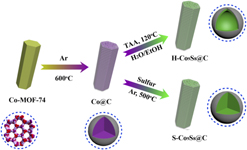Crossref Citations
This article has been cited by the following publications. This list is generated based on data provided by
Crossref.
Hua, Yi
Li, Xiaxia
Chen, Changyun
and
Pang, Huan
2019.
Cobalt based metal-organic frameworks and their derivatives for electrochemical energy conversion and storage.
Chemical Engineering Journal,
Vol. 370,
Issue. ,
p.
37.
Li, Le
Liu, Yunpeng
Han, Yinghui
Qi, Xiaohan
Li, Xue
Fan, Hui
and
Meng, Liang
2019.
Metal-organic framework-derived carbon coated copper sulfide nanocomposites as a battery-type electrode for electrochemical capacitors.
Materials Letters,
Vol. 236,
Issue. ,
p.
131.
Xu, Yuxia
Li, Qing
and
Pang, Huan
2020.
Recent advances in metal organic frameworks and their composites for batteries.
Nano Futures,
Vol. 4,
Issue. 3,
p.
032007.
Zhang, Pengcheng
Tian, Rongrong
Cao, Mengjue
Feng, Yi
and
Yao, Jianfeng
2020.
Embedding Co9S8 nanoparticles into porous carbon foam with high flexibility and enhanced lithium ion storage.
Journal of Electroanalytical Chemistry,
Vol. 863,
Issue. ,
p.
114062.
Kharissova, Oxana V.
Kharisov, Boris I.
and
González, Lucy T.
2020.
Recent trends on density functional theory–assisted calculations of structures and properties of metal–organic frameworks and metal–organic frameworks-derived nanocarbons.
Journal of Materials Research,
Vol. 35,
Issue. 11,
p.
1424.
Zhang, Yaohui
Wang, Nana
and
Bai, Zhongchao
2020.
The Progress of Cobalt-Based Anode Materials for Lithium Ion Batteries and Sodium Ion Batteries.
Applied Sciences,
Vol. 10,
Issue. 9,
p.
3098.
Xu, Tingting
Zhao, Jiachang
Li, Lanjie
Mao, Jianfeng
Xu, Jingli
and
Zhao, Hongbin
2020.
Co/Ni-MOF-74-derived CoNi2S4 nanoparticles embedded in porous carbon as a high performance anode material for sodium ion batteries.
New Journal of Chemistry,
Vol. 44,
Issue. 30,
p.
13141.
Yang, Shu-feng
Yang, Shu-lei
Qu, Jing-long
Du, Jin-hui
Gu, Yu
Zhao, Peng
and
Wang, Ning
2021.
Inclusions in wrought superalloys: a review.
Journal of Iron and Steel Research International,
Vol. 28,
Issue. 8,
p.
921.
Wang, Jie
Zhao, Shuo
and
Xian, Xiaochao
2021.
Co9S8@partly-graphitized carbon composites obtained through catalytic graphitization strategy as anode materials for lithium-ions batteries.
Journal of Electroanalytical Chemistry,
Vol. 897,
Issue. ,
p.
115569.
Su, Xiao
Li, Wen
Sun, Haining
Wang, Jian
Hu, Sisi
Yuan, Fei
Zhang, Di
and
Wang, Bo
2022.
Porous carbon-confined CoxSy nanoparticles derived from ZIF-67 for boosting lithium-ion storage.
RSC Advances,
Vol. 12,
Issue. 2,
p.
939.
Zhou, Jian-En
Chen, Jiahao
Peng, Yanhua
Zheng, Yongqian
Zeb, Akif
and
Lin, Xiaoming
2022.
Metal-organic framework-derived transition metal sulfides and their composites for alkali-ion batteries: A review.
Coordination Chemistry Reviews,
Vol. 472,
Issue. ,
p.
214781.
Hua, An
Zhou, Wenyang
Li, Yong
Li, Shuaizhen
Cheng, Renfei
Yang, Jinxing
Luan, Jian
Wang, Xiaohui
Jiang, Chunhai
Li, Da
Ma, Song
Liu, Wei
and
Zhang, Zhidong
2022.
A novel strategy for synthesizing the large size Co9S8@C nanosheets as anode for lithium-ion batteries with superior performance.
Journal of Alloys and Compounds,
Vol. 895,
Issue. ,
p.
162668.
Wang, Jie
Zhao, Shuo
Wang, Jin
and
Xian, Xiaochao
2022.
In-situ embedding Co9S8 nanoparticles in polyaniline-based carbon nanotubes for enhanced lithium storage.
Journal of Alloys and Compounds,
Vol. 919,
Issue. ,
p.
165819.
Quainoo, Timothy
Lavan, Sydney N.
and
Liu, Zhen-Fei
2022.
Van der Waals density functional study of hydrocarbon adsorption and separation in metal–organic frameworks without open metal sites.
Journal of Materials Research,
Vol. 37,
Issue. 1,
p.
334.
Liu, Ting
Peng, Jiayao
Xu, Yuting
and
Huang, Jianlin
2023.
Zeolitic Imidazolate Frameworks Derived Co9S8/Nitrogen‐Doped Hollow Porous Carbon Spheres as Efficient Bifunctional Electrocatalysts for Rechargeable Zinc–Air Batteries.
ChemPhysChem,
Vol. 24,
Issue. 2,
Gao, Ning
Shen, Xuetao
Liu, Yifan
Xu, Zhanwei
Wang, Xi
Liu, Hangyu
Ren, Yuchuan
Chen, Siyu
and
Li, Zhi
2023.
Co-Co9S8-NC particles anchored on 3D hyperfine carbon nanofiber networks with a hierarchical structure as a catalyst promoting polysulfide conversion for lithium–sulfur batteries.
Journal of Materials Chemistry A,
Vol. 11,
Issue. 10,
p.
5212.
Wang, Shaochen
Qu, Chenwei
Wen, Jiawei
Wang, Chunxia
Ma, Xinlong
Yang, Yue
Huang, Guoyong
Sun, Hongyu
and
Xu, Shengming
2023.
Progress of transition metal sulfides used as lithium-ion battery anodes.
Materials Chemistry Frontiers,
Vol. 7,
Issue. 14,
p.
2779.
Zhang, Meng
Deng, Zhao-Peng
Zhang, Xian-Fa
Huo, Li-Hua
and
Gao, Shan
2024.
Co9S8/Biocarbon Tubular Nanocomposite with Low-Temperature Performance for Lithium Storage.
ACS Applied Nano Materials,
Vol. 7,
Issue. 5,
p.
5396.
Zhang, Fuli
Liu, Yi
Su, Xue
Hou, Zibing
Zheng, Dingli
Wang, Yufei
Guo, Ruihua
and
Ma, Chao
2024.
Thermodynamic analysis of the oxidation behaviour of lanthanum in GH4169 alloy during electroslag remelting.
Ironmaking & Steelmaking: Processes, Products and Applications,
